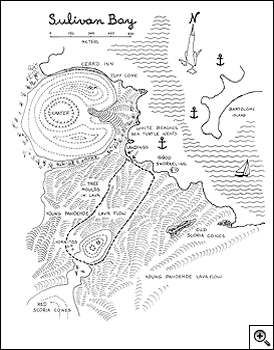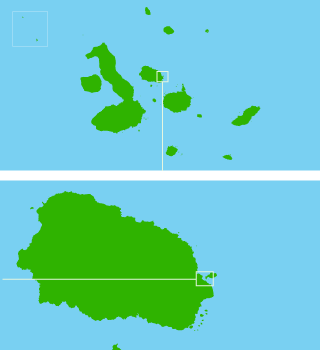

| Sullivan Bay |
Santiago Island |

Permitted Uses:  Interpretive Group Tour with a Naturalist Guide Interpretive Group Tour with a Naturalist Guide  Photography and filming Photography and filming  Guided walks Guided walks  Associated Activities authorized by the GNPS in the itineraries of Authorized Vessels Associated Activities authorized by the GNPS in the itineraries of Authorized Vessels

|
This site is of great geological interest. It is located southeast of Santiago Island, the landing can be performed either in the rocky shore (dry landing) or the white sand beach (wet landing). The length of the trail is approximately 1.5 km; travel time is one hour and a half.
The area is covered by Pahoehoe lava flows (solidified lava in corrugated or accordion form). It was very active in the last 25 years of the nineteenth century. The Sullivan lava formed in 1897. This flow is a geologically very young. The magma formed is flat, but the movement of underground lava, the rapid cooling and other eruptions led to the break in many places. |
|

Click on the illustration to enlarge.
|
These formations have a thickness of 1.5 m and did not cover much of the previous relief forming "kipukas" (Islands of vegetation surrounded by newer lava tides). Islands consisting of reddish yellow hills that protrude from the black lava that surrounds them. These elevations are tuff cone-shaped small volcanoes, similar to hornitos and with grooves that appeared long before the lava flow.
These hornitos are in the area near the sea and the right side of Red Hill, and were created when the lava was still hot and liquid gas still remained trapped in small cracks below the surface of the magma, when eventually the gas found an outlet and the lava, liquid and glassy was ejected.
At 150m from the beginning of the path molds of some trees can be found, details of the crust indicate that they were trees growing in small crevices where soil and moisture accumulate in sufficient quantity so they can grow.
Special Indications
-
On this site, many geological features have been damaged, especially the glass bubbles of lava (hornitos). Make sure your visitors do not touch sensitive formations, and do not collect anything. The damaged lava does not disappear or get repaired.
-
200 m around the landing, you can see patterns of vegetation that were burned during the eruption.
- A visit to this area of black lava is preferable in the afternoon because the temperature is more pleasant and the light is better for photographs.
|


![]()


![]()